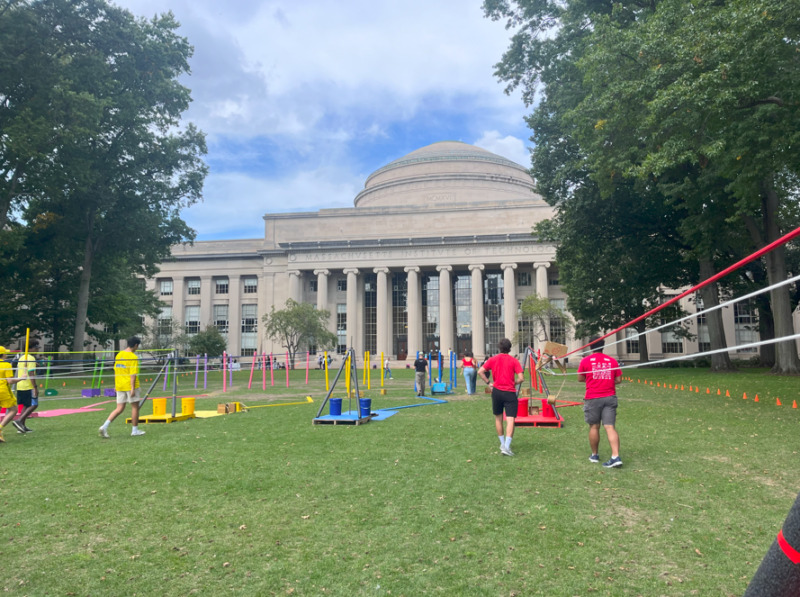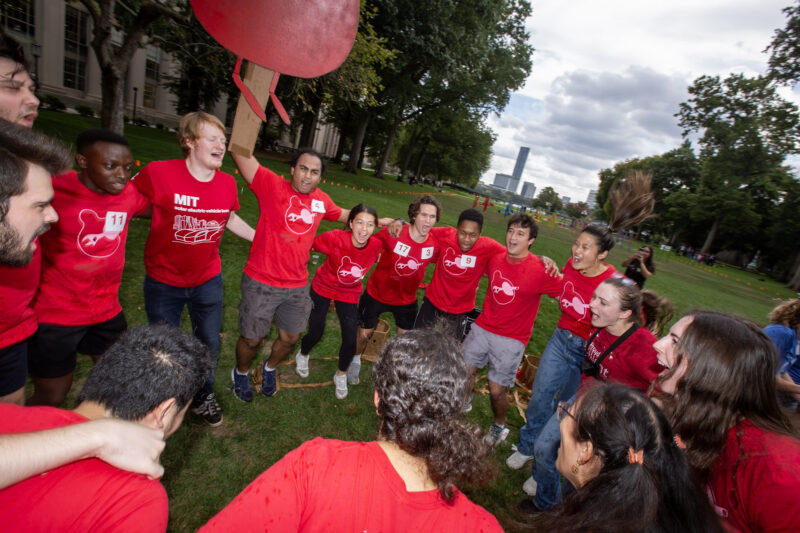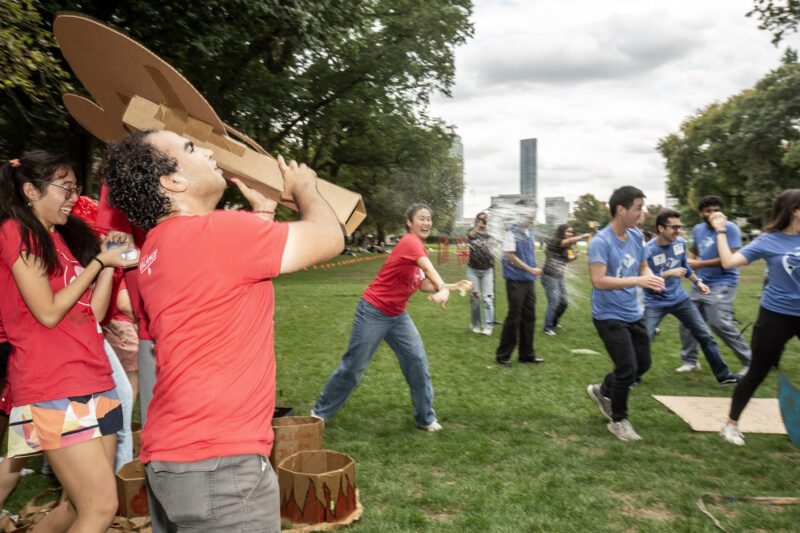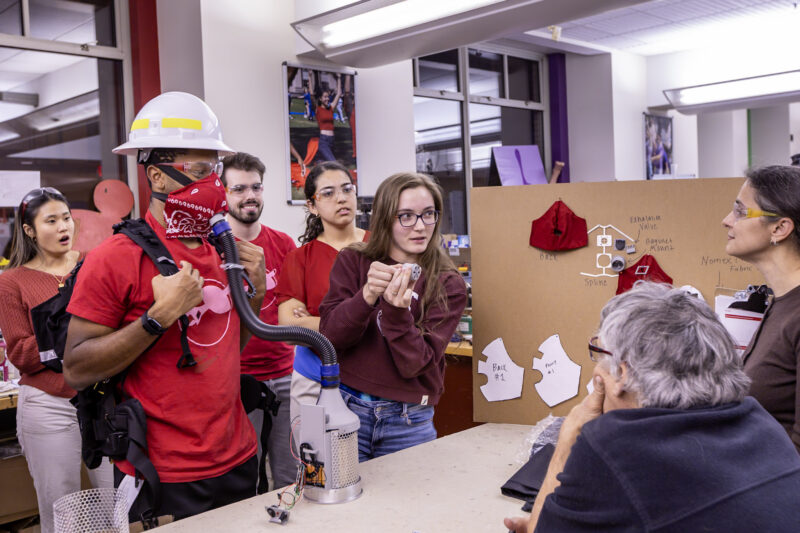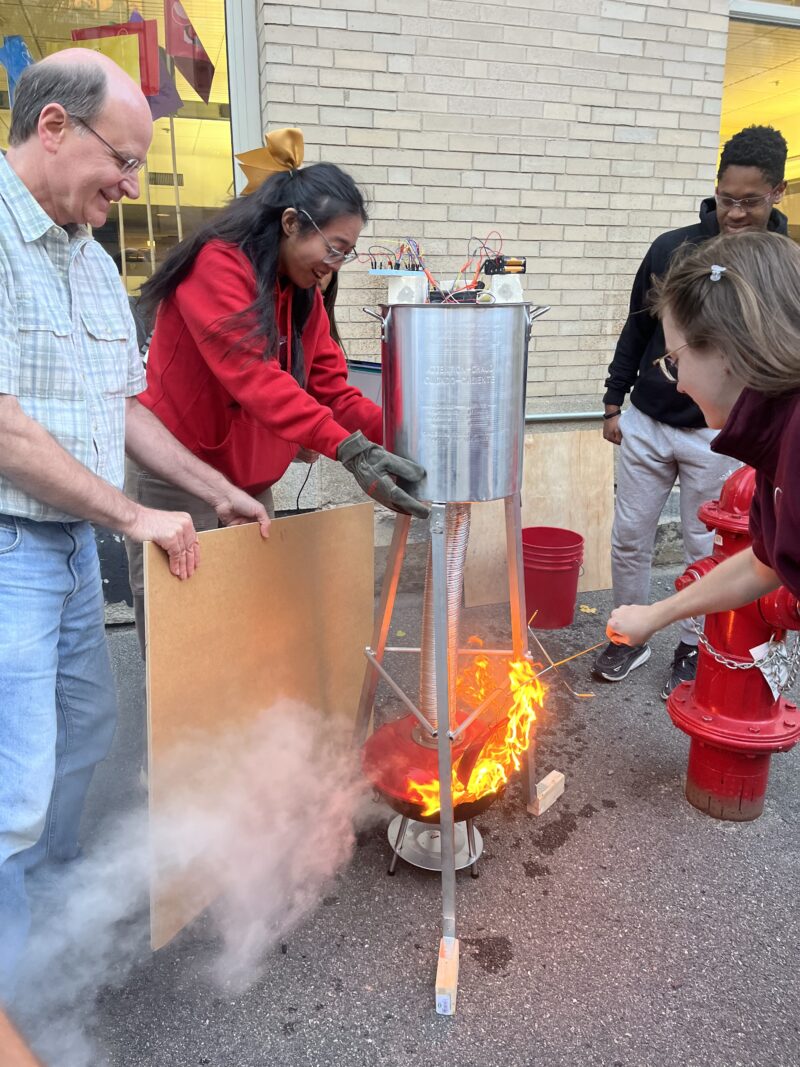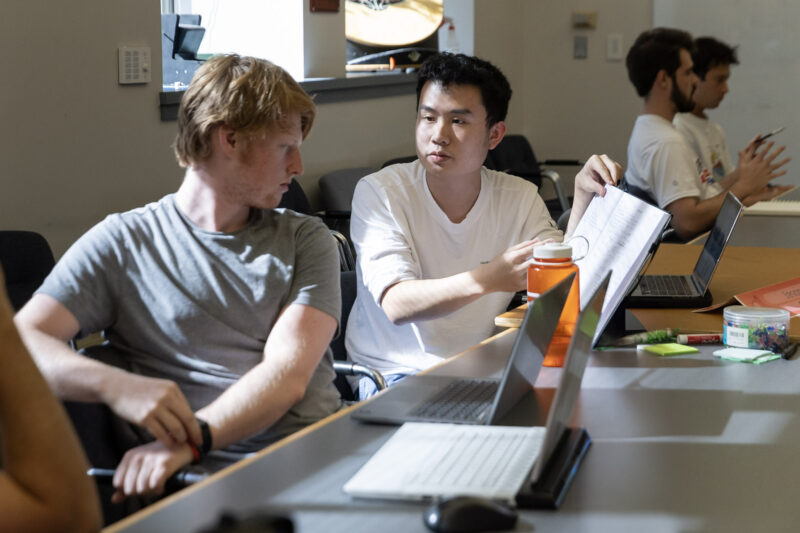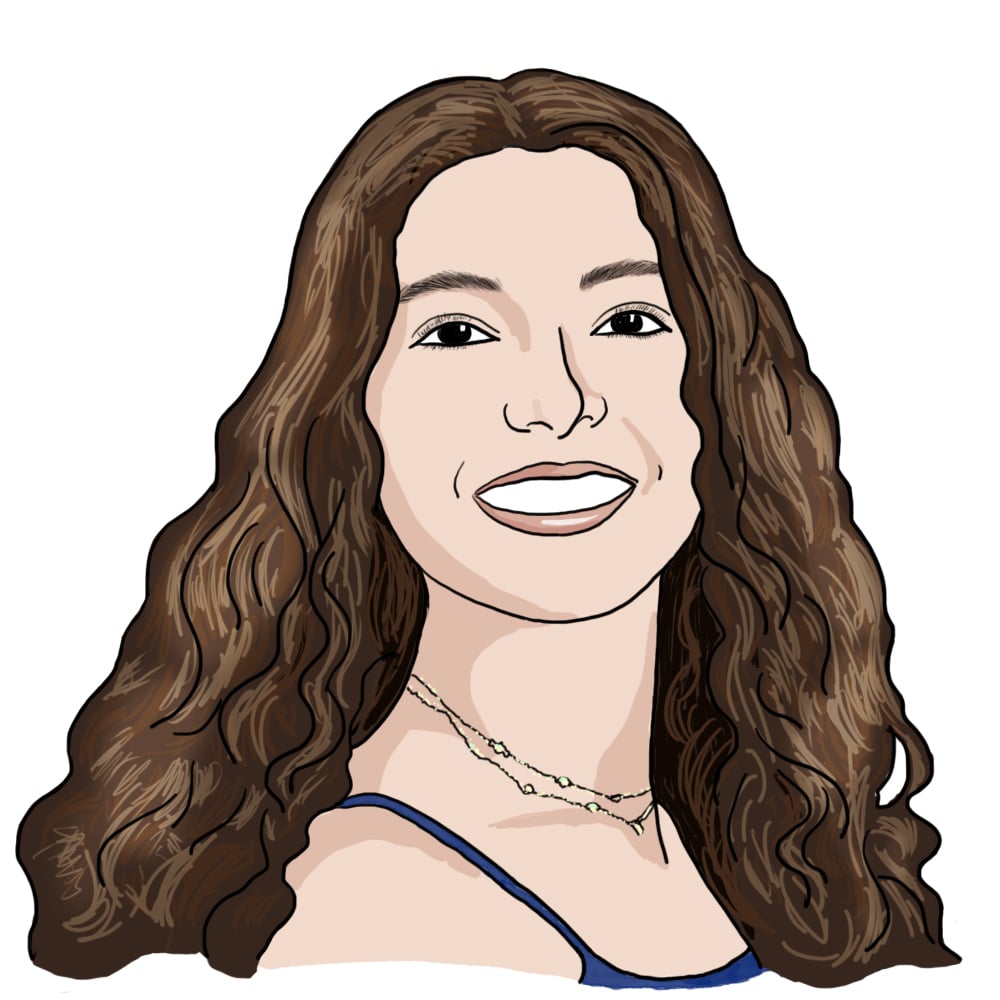
2.009: the product engineering process by Emiko P. '25
the best class at mit
For some schools, the biggest events of the year are rambunctious homecoming weekends and rivalry football games broadcasted on ESPN. At MIT, though, nothing beats the energy and celebration of the 2.009 Prototype Launch – the biggest party of the year. Equipped with enough fanfare to welcome the Queen of England, including a DJ, acapella groups, dance teams, and ridiculous amounts of confetti, this event is a must-see for any MIT student.
The 2.009 Prototype Launch is the final presentation for one of the most famous classes at MIT – 2.009: the Product Engineering Process. It’s a capstone class for Mechanical Engineering seniors, where the students are broken up into six teams of about 15 people each, and you have 12 weeks to create a prototype and present it to a live audience of over 1000 people.
How the final presentation itself went is pretty well covered in this liveblog by Janet and Kayode, and you can watch the livestream itself here, so I will focus more on the 2.009 experience as a student and walk you all through my team’s process throughout the semester.
Let’s start with my team: the Red Team. Somehow fate took all the smartest, funniest, and coolest people ever and put them all on this team. Your experience in 2.009 can depend a lot on your team, so I feel super lucky with how it worked out for me.
We had just 12 weeks to go from learning each other’s names to presenting our product, the world’s first ever powered respirator for wildland firefighters, in MIT’s biggest auditorium. Come and see how we did it.
6 opportunities in 6 minutes: 12 weeks until launch!
Getting 17 people on the same page is not an easy feat, which became immediately clear after Red Team’s very first meeting. We were tasked with coming up with six “opportunity spaces,” which we would be pitching to our entire class later that week.
As we were coming up with ideas in our brainstorming session, things were steadily getting more tense between the team. What the heck is an “opportunity” anyway? We began to bicker, as we all had different definitions for what we were supposed to be working on. Is an “opportunity” broad (ex: Fires) or specific (ex: Fires caused by lithium ion batteries in landfills)? It goes to show how important being on the same page would be for our team.
Not going to lie, I was a bit nervous leaving that first meeting. What if the semester would be fraught with drama? I was already getting the sense that the social and personal aspect of the class would be just as important as the actual engineering.
We regrouped a day later, with a fresh slate and with a definition for what would actually constitute an opportunity (which turned out to be somewhere in the middle of broad and specific, for example: Fires in landfills), and from that point on, we learned to manage and communicate any conflicts without nearly as much tension and frustration as that first meeting.
It was from that moment on that The Red Team started becoming a powerhouse.01 I think working through that initial conflict, even if it was brief, was essential for our team to become more cohesive.
Later that week, we presented our six opportunities, which ranged from railway safety to food waste management to containing forest fires.
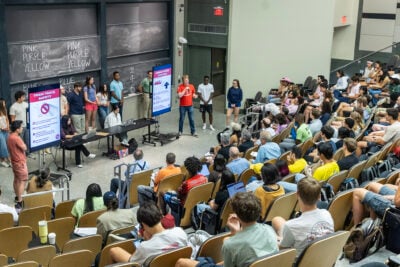
Feasibility Model Presentation: 10 weeks until launch!
Taking inspiration from the six opportunities, we narrowed down our pool to four different ideas. First, we had to identify the Killer Question, aka what is the one thing that would kill our product’s viability. Second, we had to build a model demonstrating an answer to this Killer Question, which could either be a technical model (some code and math demonstrating that a product would work) or a physical model.
Our four ideas included an urban sapling hydration system, a dysautonomia exercise aid, a geothermal drilling noise mitigation device, and a wildland firefighting mask (which is the one we ended up going with). Just to show you guys an example, the Killer Question for the wildland firefighting mask was: Can we provide both sufficient filtration and breathability? Wearing something like an N95 mask is uncomfortable on its own – now imagine wearing a mask while running a marathon, wearing at least 40 pounds of gear, and being surrounded by an out-of-control wildfire. A product like this would not be viable.
Our answer to this killer question was this: A battery-powered system that allows for high filtration without sacrificing the breathability and comfort of the user. We created a model to show that this solution was feasible, by doing a power calculation as well as an airflow calculation to show that it was possible to assist airflow enough to ease the comfort of the user while also using a reasonable number of batteries.
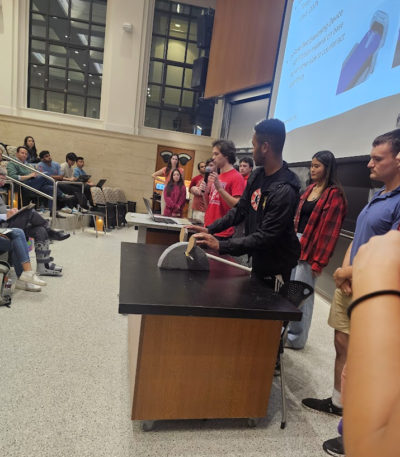
Team Build Challenge: 9 weeks until launch!
Fun team bonding! This was a challenge where each team would be racing to complete an obstacle course. The goal was to transport 100 water balloons to the end of the course using mechanisms we had built in lab earlier that week. I’ve never screamed and laughed so hard – especially when our first mechanism immediately failed and we were forced to bypass the first obstacle by frantically jumping in a potato sack. Pink team won the challenge this year! And you can only imagine what happened after the challenge was over… It’s not like we were going to let six hundred water balloons go to waste.
Concept Review: 8 weeks until launch!
We down selected from our four ideas and went forward with the Wildland Firefighting Respirator. Wildland firefighters are an interesting user group because, unlike firefighters who put out fires inside of buildings, wildland firefighters rarely wear masks out in the field. And if they do, it’s usually just a bandana soaked in water. The brave firefighters defending our homes and land deserve a safer solution – an issue that has unfortunately become even more dire due to the recent wildfires ripping through LA. With not a single powered respirator for wildland firefighters existing on the market, we decided we would create the first.
The Concept Review was basically an elevator pitch of our concept: a battery-powered wildland firefighter respirator with a focus on comfort and safety. At this point, we were doing as many user interviews as possible by building our contacts within the wildland firefighter community. These interviews helped us pinpoint features that would make them want to wear our respirator versus what would drive them away.
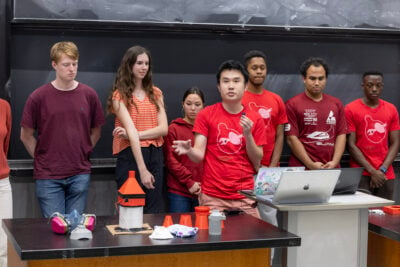
Architecture Review: 6 weeks until launch!
We were halfway through the semester! By this point, we had made some key progress, including:
- Fan selection.
- Filter selection.
- Diffuser testing.
- Preliminary PCB design.
- Power specs.
- Mask components.
- Preliminary CAD assembly.
During Architecture Review, we presented our progress, answered questions from professors, defended our design decisions, and breathed a sigh of relief that it all went smoothly. Then, we got ready to take a much needed break – SIKE!!! Only six weeks until product launch (one of these weeks being Thanksgiving break) and you think we’re taking a break??? No way.
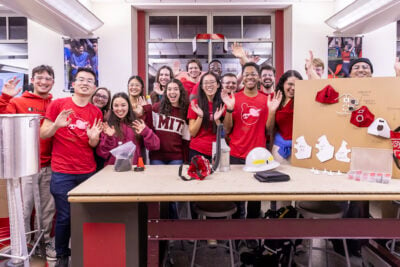
Technical Review: 3 weeks until launch!
We continued iterating on our product based off of the advice given to us during Architecture Review. After three weeks of hard work, we finally had our first functioning prototype of Vortex. During Technical Review, we demonstrated the prototype to our professors in our manufacturing lab, Pappalardo, where they gave us some final feedback for our product.
And with that, we had only a few weeks to integrate all these changes and build not one, but two, final prototypes for the Final Presentation. The team put in so many hours during this final sprint, and there was always someone to be found downstairs in the lab. We were machining, sewing, assembling, soldering, setting things on fire, and praying that everything went smoothly. Miraculously, this hard work paid off and we had our final prototypes done two days before the Final Presentation. The feeling of seeing the final product can only be described as exhilarating.
Final Presentation: prototype launch!
Peeking behind the towering curtains of MIT’s biggest stage, all you could see was an undulating, feral crowd of nerds waving rainbow pom poms and cheering at the top of their lungs.
The day had finally arrived.
It was time to present Vortex, our powered respirator for wildland firefighters. Our three presenters stepped onstage to the sound of deafening applause, and the rest of the team stood backstage, watching with bated breath.
The crowd cheered as we demonstrated the features of our product, and when we announced that Vortex was capable of filtering air to be 200x cleaner,02 This stat shows the importance of iteration. We performed this test several times at the local fire station, and with our first iteration, the device did not clean the air at all, with the second, the air was 4x cleaner, and with our third iteration, the air was 200x cleaner. These changes may seem dramatic but failing hard and early was essential for us to apply all of our learnings and achieve an off-the-charts score. Also, for reference, an N95 mask only makes the air 10x cleaner. the applause was thunderous.
The Prototype Launch was an awesome experience. I remember watching these presentations every year for the past three years and thinking, How in the world did they make that in a semester? Now I know.
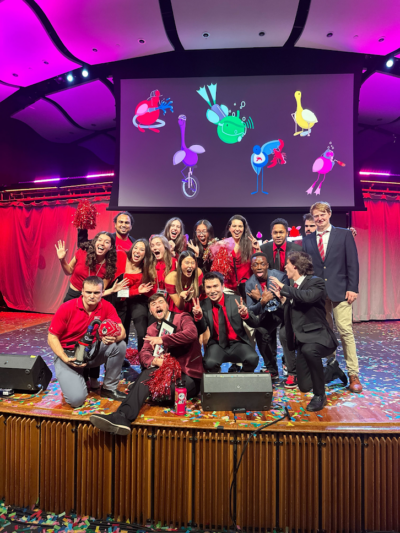
Personal Reflections
The design process has a bunch of phases, as you can tell from the breakdown of the weeks I just outlined. One of my favorite phases was the ideation phase. The brainstorming meetings with the team were awesome – especially when an idea pitched by one team member would snowball, collecting ideas and feedback from the rest of the team, and turn into a really exciting prospect.
Although the development process was a grind and probably the most frustrating part for me personally, it was so rewarding that it was also one of my favorite phases of the design process. I was on the Manufacturing Team with two other team members, and we were responsible for figuring out what materials our product was going to be made out of and how. We played around with composites, 3D printing, and molding. For the final product, I was working on the lathe to machine the cap to our filter and was working on other miscellaneous integration steps that had to be done to assemble our many parts together. I think one of my favorite days of the entire semester was when we finished integrating the final product just as the cleanup music in the lab started playing at 9 pm. 5 minutes later, we were all kicked out of lab, but we had beautiful pictures of our final product, and in our Slack channel, everyone was basking in the glory of our hard work.
Something else I learned is that the design process is not perfect. You don’t just stumble upon a gold mine of an idea. You have to research. You have to talk to as many users as possible. You have to be willing to pivot if you learn that your idea is already patented, physically impossible, or nobody’s going to use it. You have to keep trying and iterating and building. And maybe most importantly of all, you have to work as a team.
The Red Team was awesome throughout this whole process. We kept each other accountable but also were willing to hold out a hand when people were falling behind or needed help. Vortex is the result of 17 brains coming together and transforming an idea into a product, creating the world’s first ever battery-powered mask for wildland firefighters. This project was so fun!!
Thank you to the amazing staff of 2.009, especially the instructors and the Pappalardo shop crew, and congrats to the Red, Yellow, Purple, Pink, Blue, and Green Teams on designing some super sick products. I’m excited to see where this class of Mechanical Engineers goes :)
And with that, we wrap up a semester of 2.009 and a semester of Breathing Easy and Battling Hard with Vortex.
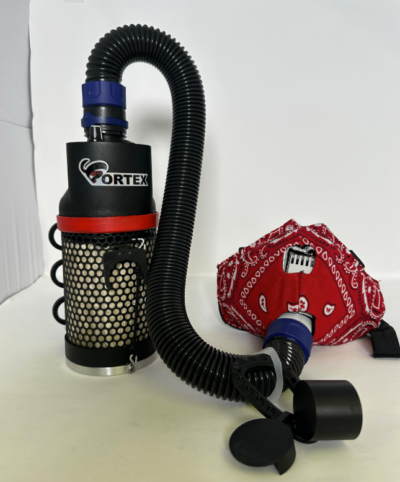
- I think working through that initial conflict, even if it was brief, was essential for our team to become more cohesive. back to text ↑
- This stat shows the importance of iteration. We performed this test several times at the local fire station, and with our first iteration, the device did not clean the air at all, with the second, the air was 4x cleaner, and with our third iteration, the air was 200x cleaner. These changes may seem dramatic but failing hard and early was essential for us to apply all of our learnings and achieve an off-the-charts score. Also, for reference, an N95 mask only makes the air 10x cleaner. back to text ↑
